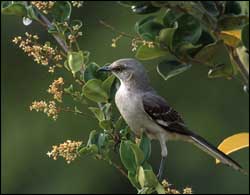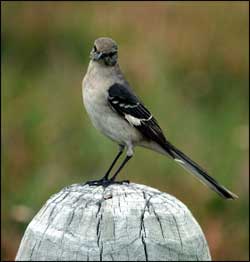Mockingbirds
The little gray songster called the mockingbird is a plain-looking bird with thin legs and a slender body that is no more than nine to eleven inches long, including its tail. Both the male and female have gray upper parts and white underparts. Their white wing patches and outer tail feathers show up in flight, and their wings and tails appear rounded. The birds look alike except the female has a little less white in her feathers and is slightly smaller than the male. Since the mockingbird's appearance is less than spectacular, you may wonder why Texas, Tennessee, Florida, Mississippi, and Arkansas have all selected the mocker as their official state bird. The secret of its popularity is its unique singing ability.
Its scientific name, Mimuspolyglottos, means "many-tongued mimic," and the Indians called it Cencontlatolly, which means "four hundred tongues." Although the Indian name may exaggerate the bird's talents, the mocker not only has a beautiful song of its own, but also can imitate the songs of dozens of other birds. It can warble, whistle, trill, and call, as well as make such interesting sounds as a squeaking gate, croaking frog, barking dog, and chirping cricket. Its mimicry is so good that an electronic device might be needed to tell the original sound from the bird's if it weren't for the mocker's habit of repeating things at least three times.

The mockingbird gets its name from its ability mimic the songs of dozens of other birds, but it also has a beautiful song of its own.
On one occasion, during an outdoor production of the symphony "Peter and the Wolf," a mockingbird added its own accompaniment to the flutist's portrayal of bird calls in the concert. Needless to say, the audience was delighted with the bird's mimicry. However, on another occasion, when a mockingbird decided to copy the sound of a traffic policeman's whistle, the bird's efforts were not appreciated. The drivers, who thought all of the whistle sounds were coming from the policeman, were confused about whether to stop or go.
Some people think the mockingbird's song is all mimicry, but researchers tell us that only 10 percent of it falls into this category. The bird actually sings at great lengths in musical phrases that are pure mockingbird song. As the bird sings, it repeats each phrase three to six times, and it can change its tune as often as eighty-seven times in seven minutes. This repetition and the sudden changes of song help distinguish the mockingbird's sounds from those of other birds.
A mockingbird will perch in a tree or sit on a telephone pole or television antenna and sing both day and night. While singing, it spreads its tail, drops or raises its wings, and may even fling itself several feet into the air without missing a note. It has been known to sing for more than an hour without stopping and is especially noisy on moonlit nights. These nighttime concerts often make it unpopular with people who are light sleepers. The mockingbird sings all year long in the southern regions, but it is most vocal throughout its range from February to July and from late August through October. Young mockingbirds can sing, but their songs are described as "soft whisper songs."
The mockingbird lives primarily in the eastern, southern, and midwestern parts of the United States and it can be found throughout Texas. It is adaptable and will make its home in both rural and heavily populated areas. Once a mockingbird stakes out its territory, it will defend that territory against all intruders, including animals much larger than itself. The size or type of opponent does not seem to matter, but the bird is not always successful in driving away the intruder.

Mockingbirds have been known to attack big birds, such as the carcacara.
Snakes create double trouble for the birds since they feed on both eggs and young. Occasionally a few well-placed pecks will discourage the snake, but all too often the reptile ignores the bird's attack. One observer reported seeing a mockingbird delivering repeated blows to the head and neck of a 2-1/2-foot black snake for more than thirty minutes without causing the snake much injury or making it change direction.
On another, more humorous occasion an observer saw a pig wander over to eat some oranges that had fallen from a tree in which a pair of mockingbirds had built a nest. The birds dived at the pig, pecking it with their beaks and beating it with their wings. But instead of being frightened away by this display of hostility, the pig seemed to enjoy the feel of their beaks pecking on its tough hide. It settled to the ground and rolled over so its broad side would be exposed to their attack. Each peck seemed to increase the pig's enjoyment. After about thirty minutes, the mockingbirds gave up and returned to their nest.
When a photographer recorded a mockingbird's attack on a caracara (a large bird also known as the Mexican eagle), he reported that the mocker's aggressive behavior did not seem to threaten the big bird. However, the nuisance of being dived at and pecked repeatedly did cause the caracara to change its perch a couple of times in an attempt to get rid of the small gray nuisance.
House cats, dogs, and squirrels are easier for the mockers to harass, and on many occasions the birds seem to be teasing the animals. There are numerous accounts of mockers attacking house cats, even though the cats are not near the nest and pose no threat to the birds. Many times the cats cannot even lie in the sunshine and sleep without being dive-bombed by the birds. Another report told how a battling mocker made a pet dog's life miserable. Every time the dog went outside, the bird swooped down and pecked its head and back. Then one day, without any apparent reason, the attacks stopped. The bird either tired of the "game" or accepted the dog as being no threat to its territory.
If you have spent much time watching squirrels playing in the trees, you may have seen one of them being chased by a mockingbird. You probably thought it was funny to see the squirrel leap from limb to limb, race down a tree trunk, run across the ground, and then scoot up another tree with a mockingbird hot on its heels, getting in a jab whenever possible. But if you had been the squirrel, you might not have seen any humor in such persistent attacks.
Squabbles between mockingbirds are not uncommon when territories are being established. Boundary disputes between two birds may be settled with a type of challenge "dance." With heads and tails raised, the birds dart back and forth across the disputed boundary until one gives ground. A mockingbird also may challenge its own image reflected in a window or shiny surface. Males and females establish their own territories except during the breeding season. It is reported that one male and female mocker, which mated with each other for several years in a row, not only established their own separate territories after raising each brood, but also defended these territories against each other. Then when spring arrived, the hostilities stopped and the pair got together again in a mutual territory until the next brood was raised.
Young mockers quickly learn to assume the threatening posture, cocking and fanning their tails while uttering sharp notes. These threatening displays are not directed at any particular object at first, but the young soon learn from their parents which animals should receive these threats.
When choosing his mate, the male attracts the female's attention by lifting and spreading his wings high above his back and displaying his white wing patches. He also moves his tail up and down, coos softly, and occasionally runs back and forth in front of her carrying a twig. The two birds may then stand opposite each other and perform a dance pattern, repeating the sequence of steps before flying away.
Both adults are involved in nest building. The male often gathers the materials while the female fits them together to form the nest. Grass, tender roots, and leaves form the lining for the small circular nest. It may take the two birds three or four days to build their nest, but the task can be finished in a single day if both birds work at a fast pace. Most nests are found in low bushes, vines, or shrubbery near buildings or along woodland edges on stumps, brush piles, and fence posts. Usually they are three to ten feet off the ground, but they can sometimes be found as low as one foot off the ground or as high as fifty feet.
The three to six eggs, normally laid one a day, are spotted with brown and may vary in color. They can be yellowish or buffy grays or shades of green, blue, brown, or purple. The incubation period is from ten to fourteen days, and the female assumes most of the duties. The male may sit on the eggs if she leaves the nest for a few minutes, but she will probably run him off when she returns. Once the eggs hatch both parents take care of the young. The young stay in the nest for about a week, and then remain close by for another few days or so. The parents will build a new nest if they raise a second brood.
Mockingbirds feed on insects, wild fruit, and weed seeds. During the spring and summer caterpillars, grasshoppers, ants, bees, and other insects make up most of their diet. While feeding on the ground, mockers may spread their wings to expose the white undersides. Some observers believe this "wing-flashing" is used to startle insects such as grasshoppers into moving so they can be seen and caught. During the winter mockingbirds eat mostly vegetable matter. Wild fruits are a favorite whenever they are available, but the birds also may eat or damage some domestic fruits. Because of their insect-eating habits, most people consider them more helpful than harmful, and no one can dispute the fact that the birds truly sing for their supper.
Our small state bird has certainly earned the title "King of Song" and also the reputation for being a scrappy fighter against all odds.
Ilo
Hiller
1989 – Mockingbirds: Introducing Birds to Young
Naturalists. The Louise
Lindsey Merrick Texas Environment
Series, No. 9, pp. 52-56.
Texas A&M University
Press, College Station.